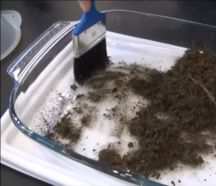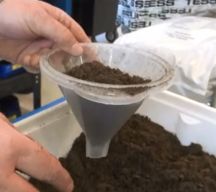
Absorbent: Here the pollutant is drawn into the particles by capillary forces. The surface remains "dry" and non-sticky.
| 
Adsorbent: The pollutant is mixed into the material, but only stays on the particles surface and never enters it. This renders the particles sticky while its structure remains unchanged.
| By far the most damaging characteristic in oils is its stickyness. Depending on the type of oil it is also dissolving and penetrating: it penetrates deep into sandy beaches and sediments where it becomes nearly impossible to dislodge. As time passes, it all solidifies into an asphalt-like substance, and it requires a very substantial effort to remove, involving both heat treatment, aggressive chemicals and sheer manpower along with money: It is a very costly operation.
The oil not only adheres and "clings" to stone and sand, but also to animals. Specially birdlife is exposed: A spot of oil the size of a dime effectively destroys the plumage's insulating properties but also the buoyance: the bird cannot stay afloat.
The toxic properties of the pollutant varies, but it is always a factor both in the short and long timespan.
Kallak Absorbent is a long step in solving these problems. When the Kallak Absorbent is dispersed over a spill is is easily drawn into it. Kallak Absorbent actually turns the biggest problems into the biggest assets: The wind and wave movements promotes the mixing in by sheer mechanical effect. Thus the feared beaching or landfall is no longer the ultimate disaster, but merely helps mixing the pollutant and the Kallak Absorbent into a "dry" and non-sticky substance that iseasily collected.
|


1: Spreading pollutant

2: Dispersing Kallak Absorbent

3: Mechanically mixing in

4: Collecting the dry mix
|
|


1:Spreading pollutant

2: Dispersing Kallak Absorbent on
the surface

3: Mechanically mixing in

4: Collecting the "dry" and
non-sticky mix

5: Oil collected
|
|


1: Preparation

2: Adding Kallak Absorbent
as a filter

3: Mixing water and pollutant

4: Adding the pollutant
over the absorbing mix

5: Clean water out

6: The resulting mass is "dry" and non-sticky. Just collect it.
|
|